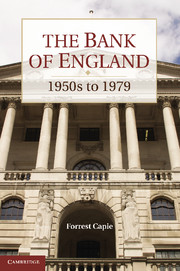Book contents
- Frontmatter
- Contents
- List of Illustrations
- List of Figures
- List of Tables
- Foreword by Mervyn King
- Preface
- Acknowledgements
- Abbreviations and Acronyms
- 1 Introduction and Overview
- 2 The Bank in the 1950s
- 3 The Monetary Setting and the Bank
- 4 The Bank's External Responsibilities to 1964
- 5 From Crisis to ‘Crucifixion’
- 6 Domestic Monetary Policy after Radcliffe
- 7 Other Activities and Performance
- 8 Sterling from Devaluation to Smithsonian
- 9 The Road to Competition and Credit Control
- 10 Competition and Credit Control
- 11 The Secondary Banking Crisis
- 12 Banking Supervision
- 13 Monetary Targets and Monetary Control
- 14 The Bank and Sterling in the 1970s
- 15 The Bank's Freedom to Operate
- 16 Epilogue
- Bibliography
- Index
- Titles in the series
8 - Sterling from Devaluation to Smithsonian
Published online by Cambridge University Press: 05 July 2011
- Frontmatter
- Contents
- List of Illustrations
- List of Figures
- List of Tables
- Foreword by Mervyn King
- Preface
- Acknowledgements
- Abbreviations and Acronyms
- 1 Introduction and Overview
- 2 The Bank in the 1950s
- 3 The Monetary Setting and the Bank
- 4 The Bank's External Responsibilities to 1964
- 5 From Crisis to ‘Crucifixion’
- 6 Domestic Monetary Policy after Radcliffe
- 7 Other Activities and Performance
- 8 Sterling from Devaluation to Smithsonian
- 9 The Road to Competition and Credit Control
- 10 Competition and Credit Control
- 11 The Secondary Banking Crisis
- 12 Banking Supervision
- 13 Monetary Targets and Monetary Control
- 14 The Bank and Sterling in the 1970s
- 15 The Bank's Freedom to Operate
- 16 Epilogue
- Bibliography
- Index
- Titles in the series
Summary
Whereas the devaluation of 1949 appeared to offer some resolution of the currency difficulties, that of 1967 did not, and sterling continued to struggle. In addition, the possibility of further devaluation and other drastic measures arose almost immediately. At the same time, there were other international monetary problems that were worsening. In the United States, as domestic policy increasingly took precedence over international considerations, further pressure developed on the dollar and hence on other currencies. Gold also felt the pressure. Sterling could not readily be separated from these problems, and in the years after devaluation, the developing tensions were such as to engulf the whole system. New sets of arrangements followed in the early and mid-1970s that owed less to design and more to the consequence of failing to find solutions to the problems. Sterling's devaluation was followed by the related collapse of the Gold Pool. The International Monetary Fund (IMF) pressure on the United Kingdom to accept conditions under the new standby and the tightening of policy were accompanied by continuing attempts to settle the sterling area questions. The debate on floating persisted, as did the use of exchange controls to stem both outflows and inflows, and there were, too, the attempts at reforming the international monetary system.
The immediate reactions to sterling's devaluation were largely predictable. When the Governor made his first speech in public following devaluation, he spoke with feeling of the frustrations that had been building over the previous years.
- Type
- Chapter
- Information
- The Bank of England1950s to 1979, pp. 372 - 426Publisher: Cambridge University PressPrint publication year: 2010



